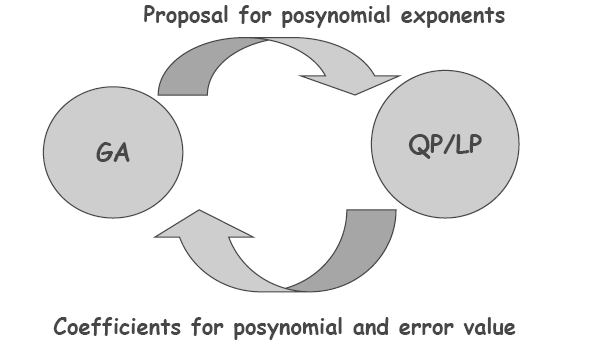Improving Accuracy of Geometric Programming for Circuit
Optimization:
Regression Using Evolutionary Algorithms and Convex Optimization
Lynne Salameh, Varun Aggarwal & Una-May O'Reilly
WHAT?
Circuit optimization has primarily taken two directions, first that
of stochastic black-box optimization with SPICE-based evaluations [1]
(also known as simulation-based approach) and second, that of expressing
the circuit as equations which are then plugged into a geometric program
solver [2]. The former requires little effort and time from the circuit
designer who only has to setup SPICE scripts for performance measurement
of the circuit and to choose which variables are optimized. However,
the optimization is slow since SPICE is invoked in-loop for every iteration
of the optimization and there is no exploitation of the knowledge of
the particular circuit being optimized. Also, blackbox optimization
gives no guarantee of finding the global optima. The latter approach,
that of equation based optimization using geometric programming, requires
effort and time on part of the designer to write accurate equations
for the circuit. Once the equations are written, very fast interior
point algorithms are used to find the global optima. Though the optimization
algorithm guarantees global optimization, the inaccuracy in the optimization
is due to inaccurate circuit equations and transistor models. These
inaccuracies and the requirement of expressing models in the form of
posynomials can be prohibitive.
Given the above scenario, the industry has adopted black-box optimization
as a tool-based approach, where the designer can use a blackbox
optimization tool to size any circuit he/she wants. This approach is
prohibitive for very large circuits. Geometric Programming has shown
some acceptance as an IP-based approach, where geometric programs
for particular circuits (popularly called IP in semiconductor industry)
are written and these circuits can be very quickly optimized/ported
to a new technology. Extension to new circuits is not straightforward
and requires time and effort.
In the state-of-art, the dominating problem with geometric programming
is the inaccuracy of the transistor models and that of circuit equations,
which leads to inaccurate optimization. We are interested in addressing
the former by building accurate posynomial models for transistors. The
simple square-law model for MOS yields monomial parameters, however
the transistor doesn't accurately follow the square law. Moreover, with
the shrinking technology, transistor behavior has become more unpredictable
and BSIM transistor model has more than 50 parameters for fitting to
fabrication data. The transition from weak inversion to strong inversion
adds another dimension of complexity obviously not captured in the square
law.
The current methods for posynomial creation are the following: i. Generation
of monomial models [3], ii. Generation of posynomial models with integer-valued
coefficients [4,5] (with local-hill climbing for fractional coefficients
[6]), iii. Piece-wise monomial fitting [7]. None of these approaches
can generate or be principally extended to produce a posynomial with
real-valued exponents and variable number of terms. Also, transistor
parameters, for instance gm, have fractional powers even with
square-law model. Thus posynomial with integer-valued powers seems inappropriate.
We want to explore methods to generate variable-term posynomials with
real-valued exponents to improve the accuracy of the transistor models.
We shall then measure the gain in the accuracy of the optimization when
these more accurate models are used in the geometric programming flow.
HOW?
In principle, posynomial generation is a regression problem where the
polynomial can have real-valued exponents and is restricted to have
only positive coefficients. We have devised an algorithm to generate
posynomials which is a hybrid of a genetic algorithm and a convex optimization
algorithm [8] (linear programming/quadratic programming). The genetic
algorithm searches in the space of exponents, while the convex optimizer
searches in the space of coefficients. This is depicted in Figure 1.
The algorithm also uses cross-validation to ensure good model generalization.

Figure 1
We have shown that the models produced by the technique are superior
to several published techniques [9]. The technique is a general technique
to fit posynomial models to any kind of data and is extensible to different
error metrics easily. We are currently working with industry-partners
to ascertain the improvement in the optimization results due to use
of more accurate models. We are also exploring combining other machine
learning techniques such as boosting, bagging and bootstrapping data
with our algorithm for improving model accuracy,
References:
[1] B.
D. Smedt and G. Gielen. WATSON: Design space boundary exploration and
model generation for analog and RF IC design. IEEE Trans. on CAD of
Int. Circuits and Systems,22(2):213-224, 2003.
[2] M. Hershenson, S. S. Mohan, S. P. Boyd, and T. H. Lee. Optimization
of inductor circuits via geometric programming. In DAC, pages 994-998,
New York, NY, USA, 1999. ACM Press.
[3] S. Boyd, S.-J. Kim, L. Vaudenberghe, and A. Hassibi. A tutorial on
geometric programming. In Technical report, EE Department, Stanford University,
2004.
[4] W. Daems and G. Gielen. Simulation-based generation of posynomial
performance models for the sizing of analog integrated circuits. CAD of
Integrated Circuits and Systems, IEEE Trans., 22(5):517–534, 2003.
[5] X. Li, P. Gopalakrishnan, Y. Xu, and T. Pileggi. Robust analog/RF
circuit design with projection-based posynomial modeling. In ICCAD ’04,
pages 855–862, 2004.
[6] T. Eeckelaert, W. Daems, G. Gielen, and W. Sansen. Generalized posynomial
performance modeling. In DATE ’03, page 10250, 2003.
[7] A. Magnani and S. Boyd. Convex piecewise-linear fitting. In submission
to J. Optimization and Engineering, 2006.
[8] V. Aggarwal, U. M. O'Reilly, Design of Posynomial Models for Mosfets:
Symbolic Regression Using Genetic Algorithms, Chapter in Genetic Programming:
Theory and Practice IV, 2006.
[9] V. Aggarwal, U.M. O’Reilly, Simulation-based Reusable posynomial
models for MOS parameters, accepted to the Design Automation and Test
Conference, Europe (DATE), 2007. |

![]()
